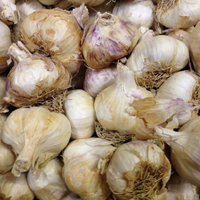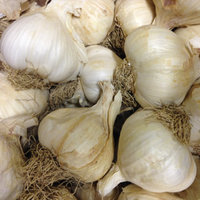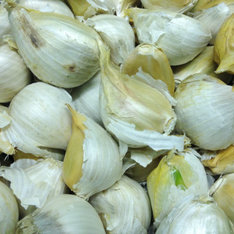Introduction To Growing Garlic
Garlic is the archetypal chef’s vegetable. There are so many dishes that demand its sulphurous pungency and flavour. Extremely good for you, we have often described its nutritional and health benefits. Growing garlic cannot be easier – even easier than growing onions and shallots.
Garlic has been grown since ancient times and was consumed in large quantities. During Tudor times, the French thought our breath stank because we were the original garlic munchers.
Garlic can also be fermented and converted to something called Black Garlic which is worth looking for in retailers and grocers and has its own unique health benefits.
The crop is ideal for the smaller vegetable plot. One of the best suppliers of garlic in the United Kingdom is on the Isle of Wight – look for garlic products from ‘The Garlic Farm‘.
Conditions For Growing Garlic
Garlic grows well in fertile, well-drained soil which can almost be sandy. Only a few varieties will thrive in wet, poorly drained soils so these are worth hunting out if you are growing in damp conditions.
Use garden compost and other organic matter to improve the condition of the soil. Word of warning though! Do not manure too much as nitrogen produces overly green and fleshy growth, prone to garlic rust. Add a little Sulphate of Potash per metre length of row which is worked into the soil in the month after tips emerge.
The time to plant garlic cloves is from September to late November and then from late January to late March. This is dependent on the variety so check details on individual types below. The plant is extremely winter hardy. This vegetable needs cold weather for at least 4 weeks where the temperature is between 0 and 10ºC (32-50F) because that encourages root formation and development. The best bulbs are grown in autumn and mature earlier than spring planting but don’t worry about that because there are some varieties that thrive on a spring start and some of the softnecks even produce a better flavour based on our tasting. The only issue is that spring planting will produce a smaller crop especially if the climate produces a poor growing season.
The soil is well raked before planting. I grow cloves which are carefully removed from the bulb mass by using a dibber to make a hole in the soil. The dibber hole is about 1½ deep (3-4cm deep) but the key measure is to plant with the bulb where the tip is one inch below the surface. I adjust the dibber depth depending on the size of the clove. The smaller it is the more shallow the hole to try and keep that 1 inch depth thereabouts. The minimum distance between planted cloves is 6 inches (15 inches).
For Elephant garlic, which produces much larger bulbs, spece the cloves about 20 to 25cm apart (8-11 inches apart). They will grow much bigger.
Throughout the growing season, remove weeds carefully as they compete with the growing bulbs. All autumn planted bulbs produce short shoots that grow a few inches before winter. The roots however should be well established and continue to grow.
Keep watered as much as possible – well into April and especially at Easter although many of these varieties enjoy some drying conditions. We stop watering around July 30th.
You can also start off cloves in small pots and modular trays where they are overwintered in a cold frame. Plant these out in early spring. Best used when a crop is already occupying space over winter which then becomes vacant for planting out in early spring. Ideal method too if your soil is especially wet during winter.
Harvesting
When the plant stem begins to topple over or bend, then we harvest. We don’t leave any later because rust becomes an issue. Dig carefully under the plant and lift with the trowel or fork. Don’t use a spade as some sites suggest because of the chance of damage ! All garlic is lifted and placed in either a greenhouse or shed to dry. Ensure good air movement as with onions – in fact they share the same space at times. Check for the neck being dry because when the stem is papery brown its ready for hanging.
If the bulb has not split then I actually replant in the vegetable patch as part of the next crop. This is especially so with elephant garlic which has a tendency not to split. I even check the splitting when the bulb is till in the ground and leave for next season’s growth. The bulb can be truly massive.
Varieties Of Growing Garlic
The two main types of garlic are hardneck and softneck. They have slightly different growing characteristics.
Hardnecks
A slightly hardier garlic than a softneck and suited to more northern climates. generally planted in autumn.
They produce a hard, central stem. They may also produce a flower spike or scape in summer which needs to be removed but can be used when chopped up in stir-fries. They produce fewer but larger cloves when forming their bulb. The varieties include ‘Lautrec Wight‘, and Chesnok Wight. The cogniscenti go for Porcelain which produces beautiful white bulbs of fewer but larger cloves and are ideal for northern climes. These store very well for hardnecks. Hardneck varieties are best grown in autumn for harvesting in June or July the following year.

Lautrec Wight is the most versatile of the hardnecks, and can be planted in autumn or early spring but dislikes wet conditions. Therefore best grown in well drained soils, almost sandy.
Carcassonne Wight grows exceptionally well in the UK. These are high quality bulbs that are pale pink and ideal in cooking because of their pungency. Plant these either in autumn or early spring.
Caulk Wight produces good sized bulbs that have pink, marbled skin. Very hardy and a strong grower. Can tolerate temperatures down to -20ºC so its ideal for cooler climates. Plant from September to January for the best growth and bulbs.
Czechmate is a garlic from Moravia in the Czech Republic. It is a vigorous variety producing large bulbs and striped cloves with an exceptionally strong flavour. Plant in October and November.
Extra Early Wight comes from France and is variety of large white bulbs with a pungent and crisp flavour. Plant in autumn for the best bulbs.
Kingsland Wight is a an excellent cooking garlic which is best grown in the south of the UK. Plant in early autumn or early spring. produces white-skinned bulbs with pink cloves. Hates wet soil.
Softnecks
These store better than hardnecks but they do prefer warmer climes for their growth. In northern areas or where the climate is much colder, start off in early spring. Softnecks produce a soft stem with a non-flowering spike and usually smaller cloves in the bulb. Most garlic from this group have a milder flavour but store longer than hardnecks. Faster growing than hardnecks.
Varieties to grow include ‘Early Purple Wight‘, ‘Iberian Wight‘, ‘Mersley Wight’ ‘Picardy Wight‘, ‘Cristo‘, ‘Tuscany Wight‘, ‘Solent Wight‘, ‘Provence Wight‘ and ‘Albigensian Wight‘. Plant from September to March. The ideal time is late winter into mid-Spring but check individual growing times. Look for ‘silver skin’ types like Mersley Wight

Mersley Wight originated in the Auvergne region of central France, and grows into the volcanic Drome department of northern Provence. The Garlic Farm who are well established purveyors of garlic gave it the name in the UK after their farm Mersley.. A delicious ‘silverskin’ variety which is ideal for a UK climate. Produces good sized cloves with a strong flavour.
Given its mountainous roots, the cloves are planted in early Spring in the UK but from late November as late as early April. The cloves are quite large for a softneck which is ideal. We plant these in mid February although a great crop has been achieved from a late November planting to get it established – the soil is relatively dry when we attempted this. This cultivar will keep until June the following year which is roughly 10 months. The flavour is excellent especially for culinary use. Has greater vigour than its cousin the Solent Wight.

Iberian Wight is a large fat white garlic with purple stripes, originating in south west Spain. Keeps to its Roman Purple colour when grown close to the soil surface.

A large white softneck garlic that can produce bulbs approaching Elephant Garlic for size. Originating in the lush valleys of Provence in Southern France. Think lavender fields, think this garlic.
Picardy Wight comes from northern France and is a variety that deals well with cool and wet conditions. Produces plump, juicy cloves and great for growing in the UK.
Provence Wight produces large white bulbs with purple streaks on strong-growing plants. The cloves are plump with soft, subtle flavour. These are one of the best varieties for growing in wet summers or when watering in full growth.
Rhapsody Wight is a strong growing bulb with purple streaks on strong-growing plants. produces large bulbs in June from an early Autumn planting. Has a strong flavour.

Solent Wight is one of the best in terms of its overall eating and keeping quality. It produces hard densely packed bulbs of cloves that exude a presence of their power especially in cooking. Good for storing – some of our bulbs have kept for 12 months in cool stored areas.

Tuscany Wight is a new softneck garlic from Tuscany. This large white garlic is a late type like Solent Wight. It has superb keeping qualities and is often the last to be used because the others simply don not store as well as this one.
Elephant Garlic
A related species to garlic and onions generally but actually a type of leek. They can grow up to 6 inches (15cm) in width. Worth growing like a garlic for its subtle, slightly garlic flavour. Make excellent roasted vegetables to garnish meats.

Suppliers:
Kings Seeds: www.kingsseeds.com
Mr Fothergill’s: www.mr-fothergills.co.uk
DT Brown: www.dtbrownseeds.co.uk
Marshalls: www.marshallsgarden.co.uk
The Garlic Farm: www.thegarlicfarm.co.uk
Sutton Seeds: www.suttons.co.uk
Revised with new information on growing conditions and varieties 2nd Novermber 2022 from the original of 8th November 2020.
Leave a Reply